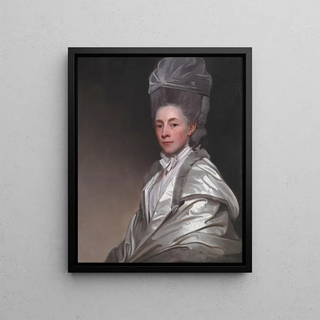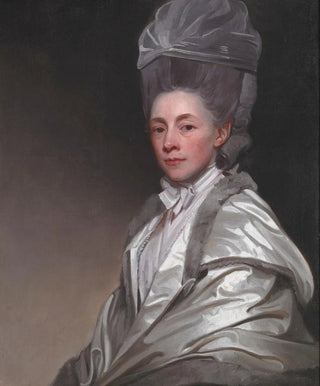Art print | Portrait of Jane Dawkes Robinson - George Romney


View from behind

Frame (optional)
The "Portrait of Jane Dawkes Robinson" by George Romney is a piece that transcends the simple frame of painting to become a part of the history of visual arts. This artwork, capturing the elegance and grace of its model, reflects an era when portrait painting was at its peak. Through this piece, Romney manages to immortalize not only the physical appearance of Jane Dawkes Robinson but also her essence, emotions, and social status. Gazing upon this creation, the viewer is invited to delve into a universe where every detail matters and where beauty intertwines with psychological depth.
Style and uniqueness of the artwork
Romney's style is distinguished by its realistic approach and his ability to render textures and lights with remarkable finesse. In the "Portrait of Jane Dawkes Robinson," the artist employs a delicate color palette that evokes the softness and luminosity of her face. Shades of pink and cream blend harmoniously, while subtle shadows add an almost lifelike dimension to the painting. Jane's slightly tilted posture, along with her contemplative gaze, creates a captivating interaction with the viewer, evoking a sense of intimacy and curiosity. This portrait does not merely depict a figure but tells a story— that of a woman of her time, both strong and vulnerable.
The artist and his influence
George Romney, an emblematic figure of 18th-century Britain, established himself as one of the most sought-after portraitists of his era. His career, marked by an relentless pursuit of perfection, led him to explore various techniques and styles while remaining faithful to his taste for realism. Influenced by the great masters of painting, he developed a unique approach that allowed him to capture the soul of his subjects. Romney's portraits stand out for their psychological depth, a characteristic fully evident in the "Portrait of Jane Dawkes Robinson." The artist evolved his art by incorporating elements of daily life and human emotions, enabling his works to resonate beyond their time.
An exceptional wall decoration signed Artem Legrand

Matte finish

View from behind

Frame (optional)
The "Portrait of Jane Dawkes Robinson" by George Romney is a piece that transcends the simple frame of painting to become a part of the history of visual arts. This artwork, capturing the elegance and grace of its model, reflects an era when portrait painting was at its peak. Through this piece, Romney manages to immortalize not only the physical appearance of Jane Dawkes Robinson but also her essence, emotions, and social status. Gazing upon this creation, the viewer is invited to delve into a universe where every detail matters and where beauty intertwines with psychological depth.
Style and uniqueness of the artwork
Romney's style is distinguished by its realistic approach and his ability to render textures and lights with remarkable finesse. In the "Portrait of Jane Dawkes Robinson," the artist employs a delicate color palette that evokes the softness and luminosity of her face. Shades of pink and cream blend harmoniously, while subtle shadows add an almost lifelike dimension to the painting. Jane's slightly tilted posture, along with her contemplative gaze, creates a captivating interaction with the viewer, evoking a sense of intimacy and curiosity. This portrait does not merely depict a figure but tells a story— that of a woman of her time, both strong and vulnerable.
The artist and his influence
George Romney, an emblematic figure of 18th-century Britain, established himself as one of the most sought-after portraitists of his era. His career, marked by an relentless pursuit of perfection, led him to explore various techniques and styles while remaining faithful to his taste for realism. Influenced by the great masters of painting, he developed a unique approach that allowed him to capture the soul of his subjects. Romney's portraits stand out for their psychological depth, a characteristic fully evident in the "Portrait of Jane Dawkes Robinson." The artist evolved his art by incorporating elements of daily life and human emotions, enabling his works to resonate beyond their time.
An exceptional wall decoration signed Artem Legrand






